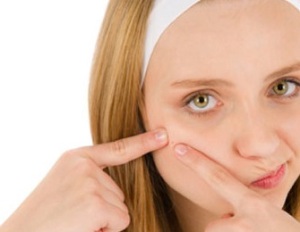The Not So Dirty Truth Behind Blackheads
Blackheads…by far and away the number one complaint I see in my guests. Everyone has tried anything promising the elimination of blackheads, from nose strips to sandpaper (I’m not joking), but there they are, your constant companion, staring back at you from the tip of your nose. So why do you have them, and why won’t they go away? Why aren’t the products you’re using working? Here are 10 truths about your blackheads to help you find your way to clearer pores.
1. Blackheads are not dirt. This is a very common misconception, and the first step to understanding the problem. Blackheads are actually pores clogged with the excess oil from sebaceous glands. Sebaceous glands are located in hair follicles and release sebum, which consists mostly of fat, keratin, and cellular material. Your body produces sebum to lubricate the hair and skin, and when it produces too much, this sebum accumulates in your pores.
2. Blackheads are named after worms. The technical term for a blackhead is an “open comedone,” which is the plural form of “comedo,” a latin word formerly given to worms that devour the body, but has since been co-opted by the medical field to describe bodily secretions that resemble the worms. Neat, right? Here’s the fun thing– a whitehead is called a “closed comedone,” because the pore is closed off from air, but the stuff inside blackheads and whiteheads are the same material.
3. So why are blackheads black? Well, remember, blackheads are open comedones, which means the tips of them are exposed to air. Oxidation causes the ends of blackheads to become black. This is why a blackhead appears black, but when you pop them, the inside part is white.
4. Blackheads are not a result of poor hygiene. Since blackheads are not dirt, the problem isn’t that you’re not washing your face enough. In fact, cleansing the skin too often or with a cleanser with too much surfactant for you, can lead to more clogged pores because it can overstrip the skin of oil. This causes your body to go into oil production overdrive.
5. You cannot scrub blackheads away. Many people think they can scrub the blackheads away, but since it’s not surface dirt, you can’t scrub it away. So why is it that your skin looks and feels so fresh and clean when you scrub? Well, when you scrub, you’re scrubbing off the oxidized tip of a blackhead, which removes the visible dark portion and uppermost layer of skin. However, the pore remains clogged and will darken again. What’s more, over-scrubbing can actually lead to more blackheads and clogged pores because it stimulates oil production to replace the oil you strip away.
6. It’s probably not an oil problem. Yes, the pore is clogged with oil, but the important question is why the oil is there. Dehydration is by far the most common cause than innate oil overproduction. When the skin gets dehydrated, it makes extra oil to make up for the lack of water, and that extra oil leads to blackheads, particularly in the nose. As I said above, excess cleansing and scrubbing, and using too harsh a cleanser, can also lead to a lack of oil in your skin and stimulate oil production.
7. Nose strips are not your friends. Yes I know it’s satisfying to pull that sucker off and see the gunk you just eliminated from your nose, but if you look again you’ll also notice along with the oil plugs you also pulled out all the fine hairs. Each of those hairs left behind an open pore, which can now get filled up with oil. Usually, use of these products end up leaving the user with more blackheads over time.
8. Back away from the magnification mirror and don’t use extraction tools. These tools are designed to be used by someone who has been trained in their use. No one but your doctor or esthetician needs to see your pores magnified by 1000x. It just leads you to think your blackheads are 1000 times worse than they are and then you’ll just freak out and want to extract them yourself. However, using an extraction tool on yourself often leads to bleeding, bruising, and broken capillaries because you probably don’t know how to use the tool without applying excess, damaging pressure.
9. Do use a hydrating toner, not an astringent. No matter what your skin type is, it can use more water. Stripping the skin of its natural moisture and hydration can lead to extra oil production and more blackheads, but adding water can help diminish oil production and lead to fewer blackheads.
10. Do schedule a facial. A professionally trained esthetician is your best resource to remove blackheads without damaging your skin or making your problems worse. They have been trained to get those wriggly little comedones out of your skin safely. However, if you absolutely, positively, 100% MUST remove the blackheads on your own, here is my suggestion: 1. Wash your face with your normal cleanser and make sure your hands are clean; 2. Wrap your index fingers with some sort of soft, clean paper or cotton product (toilet paper a cotton 4”x4” pad work best); 3. Place your fingers wide around the affected pore and squeeze gently together, in an upwards motion; 4. If it doesn’t come out easily, rotate your fingers around the pore and repeat step 3 from a different angle; 5. Once the blackhead is extracted, wipe the pore down with your toner; 6. Enjoy your date, because if you’re not going on a date that night then you have no excuse not to wait to have the blackhead extracted by a professional!
Blackheads are a normal part of life. No one will remain blackhead free forever, regardless of what you do. But, you can manage them. The best way to keep blackheads at bay between facials is to make sure your skin is as hydrated as possible– don’t over-wash or over-scrub, avoid drying products such as astringents, drink plenty of water, and try to keep your stress levels as managed as possible!
And don’t pour Tussin on it. 😀


